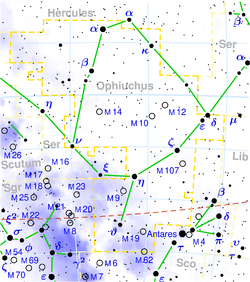- Beta Ophiuchi
-
Beta Ophiuchi Observation data
Epoch J2000.0 Equinox J2000.0 (ICRS)Constellation Ophiuchus Right ascension 17h 43m 28.353s Declination +04° 34′ 02.29″ Apparent magnitude (V) 2.75 to 2.77 Characteristics Spectral type K2III U−B color index 1.24 B−V color index 1.16 Variable type K-type giant[1],[2] Astrometry Radial velocity (Rv) -12 km/s Proper motion (μ) RA: -40.67 mas/yr
Dec.: 158.80 mas/yrParallax (π) 39.78 ± 0.75 mas Distance 82 ± 2 ly
(25.1 ± 0.5 pc)Absolute magnitude (MV) 0.75 to 0.77 Details Mass 1.13 [3] M☉ Radius 13.2[3] R☉ Luminosity 62 L☉ Temperature 4467[3] K Other designations Data sources: Hipparcos Catalogue,
Bright Star Catalogue (5th rev. ed.),
GCVS (4.2),[1],[2]Beta Ophiuchi (β Oph, β Ophiuchi) is a K-type giant star in the constellation Ophiuchus. It has the traditional names Cebalrai (Arabic: كلب الراعي kalb al-rā‘ī '"shepherd dog"), Cheleb, or Kelb Alrai, or sometimes just Alrai. Like some other K-type giants, β Ophiuchi has been found to vary very slightly (0.02 magnitudes) in brightness.[1],[2]
Planetary system?
Radial velocity variations with a period of 142 days would hint the possible presence of a planetary companion orbiting Beta Ophiuchi. So far no planetary object has been confirmed; on the other hand pulsation bound to intrinsical variability could explain observed variations.[2]
The Beta Ophiuchi system Companion
(in order from star)Mass Semimajor axis
(AU)Orbital period
(days)Eccentricity b (unconfirmed) ≥1 MJ ≥0.6 142.3 ? Namesakes
USS Cheleb (AK-138) was a United States Navy Crater class cargo ship named after the star.
References
- ^ a b c K Giants in 47 Tucanae: Detection of a New Class of Variable Stars, Peter D. Edmonds and Roland L. Gilliland, Astrophysical Journal Letters 464 (June 1996), pp. L157–L160
- ^ a b c d The Radial Velocity Variability of the K Giant beta Ophiuchi. II. Long-Period Variations, Artie P. Hatzes and William D. Cochran, Astrophysical Journal 468 (September 1996), pp. 391–397
- ^ a b c Allende-Prieto & Lambert (1999). "Fundamental parameters of nearby stars from the comparison with evolutionary calculations: masses, radii and effective temperatures". Astronomy and Astrophysics 352: 555–562. arXiv:0809.0359. Bibcode 1999A&A...352..555A.
Bayer α (Rasalhague) • β (Cebalrai) • γ • δ (Yed Prior) • ε (Yed Posterior) • ζ (Han) • η (Sabik) • θ • ι • κ • λ (Marfik) • μ • ν • ξ • ο • ρ • σ • τ • υ • φ • χ • ψ • ω • b • c • d • e • f • p • AFlamsteed 1 (δ, Yed Prior) • 2 (ε, Yed Posterior) • 3 (υ) • 4 (ψ) • 5 (ρ) • 7 (χ) • 8 (φ) • 9 (ω) • 10 (λ, Marfik) • 12 • 13 (ζ, Han) • 14 • 15 • 16 • 18 • 19 • 20 • 21 • 23 • 24 • 25 (ι) • 26 • 27 (κ) • 28 • 29 • 30 • 31 • 35 (η, Sabik) • 36 (A) • 37 • 38 • 39 (ο) • 40 (ξ) • 41 • 42 (θ) • 43 • 44 (b) • 45 (d) • 47 • 49 (σ) • 50 • 51 (c) • 52 • 53 (f) • 54 • 55 (α, Rasalhague) • 57 (μ) • 58 • 60 (β, Cebalrai) • 61 • 62 (γ) • 64 (ν) • 66 • 67 • 68 • 69 (τ) • 70 (p) • 71 • 72 • 73 • 74 • 24 ScoNearby Barnard's Star • Wolf 1061 • 70 (p) • 36 (A) • Gliese 644/643 (Van Biesbroeck 8) • Gliese 673 • GJ 1207Categories:- Ophiuchus constellation
- Bayer objects
- Flamsteed objects
- K-type giants
- Hypothetical planetary systems
- Stars with proper names
- Extrasolar planet stubs
- Giant star stubs
Wikimedia Foundation. 2010.

